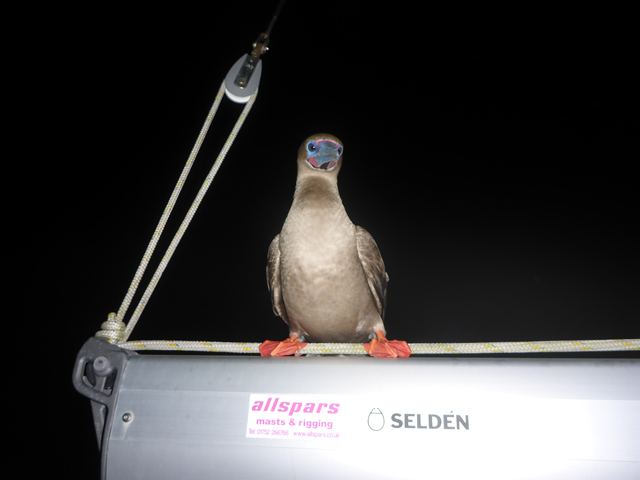Just before we left NZ we watched one of Gail’s films, a true story made by the villagers from a rural community on Tanna, one of the islands in the Vanuatu Archipelago about a young couple, Dain, son of the chief, and Wawa who together changed the marriage laws on that island forever.
They both were from the same tribe and made the fateful mistake of falling in love. Up until then bride exchanges and barters between villages were used to quell unrest, resolve arguments, maintain peace and no doubt keep the gene pool healthy, just as we learned from the Aborigine elder in Alice Springs. The village chief was adamant and so were the lovers.
The next day their villagers found them together and carried them home. The close knit group of ni Vanuatu people were so shocked and dismayed that they changed their marriage rules to accommodate same village relationships. Some good always comes from human tragedy doesn’t it.
We plan to visit Tanna ourselves and will arrange with a local guide to take us to the rim one evening when the molten magna and volcano voice is at its best. Dain and Wawa’s village cannot be far away but I believe outsiders are forbidden to visit so they can live as they always have.
We are now over half way to Luganville on Espiritu Santo, our landfall. The island is in the north of the group so most of the cruising will be to the south before we cross to New Caledonia and then Australia. But we are thinking of exploring some of the few islands to the north first.
Before telling you about the trip so far I want to bring you up to date on our stay in Marsden.
We got to know Simon and Elaine Bliss through Neville and Sharon and enjoyed a fish (red snapper) and chip supper with them in Neville’s upstairs living room overlooking the Whangarei River and Mt Manaia. Simon and Elaine started out from Falmouth in their 28 foot wooden boat, Rivale on the 5th June 1976 (the same time 1st hubby Stuart and I were taking off from Heathrow to New York to start our 7 month sabbatical touring the US and Canada in our Safari Landrover, but that story is for another time).
This was their third attempt to cross the Biscay and the start of a long and sometimes fraught journey to Whangarei where Rivale finally arrived and Simon and Elaine started their land life together. Thirty seven years on they are still together and have shared a life of adventure with all the joys, tribulations and tragedies it brings.
I have just finished reading Simon’s book ‘Sea Legs’ and it is a beautifully written book in soft back form so far published only in NZ. So along with Neville’s ‘Doumar and the Doctor’ I shall try to bring them to the attention of nautical publisher’s in the UK like Adlard Coles, now part of Bloomsbury and Penguin Random House.
Simon and Elaine now live on Geminis, a yacht they completely rebuilt and they kindly loaned us their car until we left.
I have also been editing my book about Zoonie and Teddy’s cruises from Europe to NZ and Erling Tambs’ grandson of the same name has kindly been reading them to give his slant.
On the day we had planned to leave, 3rd June, we took Neville and Sharon’s collie, Chase for the first of numerous walks and Max and Shirley and Jeannie and Merv came aboard for supper in the evening. We toasted the Queen on her Birthday and looked for a better weather window.
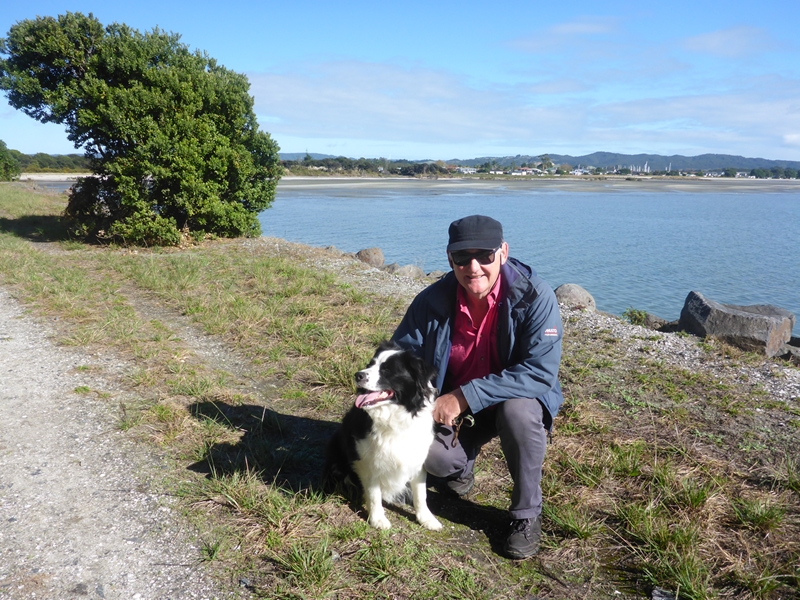
The next day dawned bright and sunny although with a promise of rough weather on the way. The walk from Neville’s house to the Refinery end of Bream Bay Beach, called Mair Beach, takes about an hour and once clear of one entrance to the logging terminal Chase went off the lead and started to explore. He kept popping back to us to ensure his ‘flock’ was still together. Sharon had told us that he knows he is only allowed to chase (!) gulls, so when I called him with a certain ‘don’t even think of going after those oyster catchers’ tone in my voice he was a good boy and left them alone.
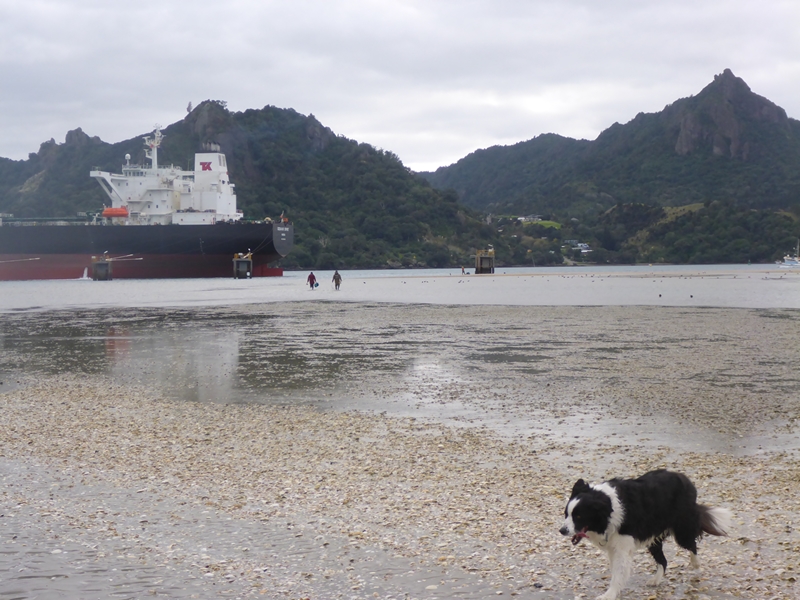
He would venture belly deep into the water after sea gulls and vent his frustration with a lot of yowling when they took off. Bless him. Back at Neville’s home we shared a light lunch and continued with the sheer pleasure of sharing their company, wandering later back to Zoonie with a big bag of walnuts from the tree Neville planted thirty years ago. The fruits of his garden.

The storm passed over and we borrowed the car to shop at Pak and Save and have lunch with Jeannie and Merv at their home. The wonder of wheels. But the turbulent weather had not yet finished with the shores of NZ.
I killed time by bringing my WordPress blog (skipperbarbwhite.com) right up to date. I never expected to be able to in the time we had left but the Marina Internet Connection reached Zoonie just fine most of the time and I was able to do almost all of it onboard, just spending a few hours in the first floor lounge by the office to finish the job with the wind howling outside and flags lifting all about the yachts.
Rob booked our Customs clearance for the 12th and we took Scoots lines as she came alongside ‘D’ pontoon, ready to make the mental transition from hive of activity Whangarei to the stepping off point from the marina.
We heard about a 45ish foot Beneteau that had been abandoned by its solo Norwegian skipper who was taken off on a Mexican freighter after the engine failed and he had had enough. We wondered whereabouts the yacht was and Brent in the office found out on Google.
“She was here last November but now she’s 2800 km from New Zealand so no threat to you guys. I expect the Navy will use her as target practice, they usually do in cases like hers.” What a shame, she looked in good shape from the photo taken by one of the freighter’s crew.
Richard told us in one of our regular chats that Rosemary, (Rob’s mum) was set up for her bowel operation on the 20th although she is very breathless from heart disease. We will keep our fingers crossed for her and look forward to a chat when we get connected in Vanuatu.
Lying in bed just two days before we left I was thinking about how Julie, on the Teddy coped with their rat infestation she had to endure across the Caribbean Sea when, you simply won’t believe this but it is true, a young rat appeared at the porthole I was looking through at the time, nosing around the outside for a place to get in. So I was glad it was closed against the frequent rain-showers at the time.
I woke Rob and, since he is a seeing is believing kind of guy, I really hoped it would be him who located it.
We whizzed into just enough clothing for decency sake and started a hunt around Zoonie’s cold wet decks (I was barefoot). After a few minutes of a worrying lack of success, “Here it is.” Rob found it in the cockpit working out how to get down below. Baby rats can move very quickly and who knows what nasty disease they carry in their mouth so Rob grabbed its tail through a well folded tea-towel and flung it as far as he could over the water, at which point it swam impressively straight back to Zoonie’s hull. This time, without the convenience of lines lying along the pontoon and unable to climb Zoon’s slippery sides it continued under the pontoon to a handy ledge Brian from the marina told me about afterwards, which gave rats somewhere nice to give birth. Rather there than on Zoonie. I was a little paranoid for a while checking decks and windows for the familiar outline, but as I write I can safely say we are a rat free Zoon, or Zone!
From then on till we left our only early morning visitors were 6 Welcome Swallows sitting on the rail in the new sunshine, warming up and they were very welcome.
The two evenings, before we sailed away from NZ shores with a small group of other yachts, were spent dining firstly with Vandy and Eric from Scoots and David and his daughter Tessa and son in law Nick and their German friend Anna from Rewa at a very nice Indian restaurant out in the sticks beyond Ruakaka, how do they make a living? We shared a few small dishes of deliciously spiced food for £12.50 each!
The number increased to over 20 on the last evening as we descended on the marina’s own restaurant, Land and Sea, which did us proud yet again and made for a memorable last day. Cetacea arrived after her two year refit with Gail and Tony as enthusiastic as they were trepidatious, “It’s so long since we sailed and there are so many new systems!” They joined us for the occasion.
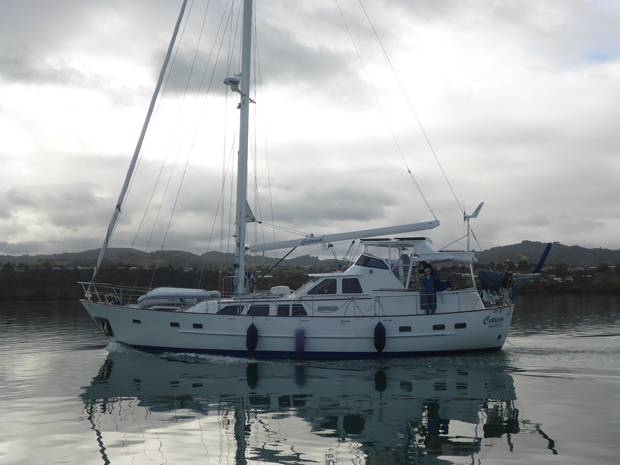
Tessa told us an interesting story about a solo sailor her dad Dave knew when he was a marina manager. As I don’t know his name I will call him Jim and he was a professional writer. Each summer he would disappear into the blue in his little 28 footer for a few months and tell Dave about his exploits when he got back.
On one such return he was not in his usual vessel. A few weeks before when he was sailing offshore and in the brief interval while he was below brewing a cup of coffee he thought he heard ship engines and on looking outside saw a colossal oil tanker bearing down on him at speed. The next thing he remembered was rising to the sea surface amongst the debris that had been his home and having just a few planks to hold on to he wondered seriously about his fate.
After a lonely period of time he saw a ship coming over the horizon, the very same one that had blown his boat apart, the impact being so great they cannot have seen his vessel. But because the tanker was empty they heard the noise, had it been full the outcome would have been quite different. The captain and crew realised what had happened. With Jim safely aboard the captain apologised profusely and gave him the best care possible until they arrived at the port from which Jim could make it home.
A few days later Jim received an open cheque from the Exxon oil company and he told Dave this story from the deck of his 48 footer. Nice one Jim.
At 10.50am we sailed out of the marina for the last time and waved back to Neville who was standing outside on his balcony giving us a warm send off. The next time we would see New Zealand we would be arriving on a big bird and who knows when that will be. But we will keep in touch with our dear friends.
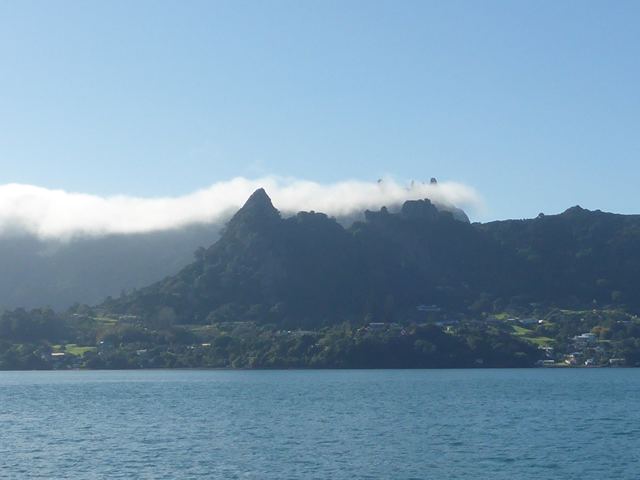
By 10.15pm with the engine off we were reefing the main and with the pull of her brand new genoa, Zoonie swished along in 8-25 knots of wind. Each clad in trousers and leggings and t-shirts and fleeces, two pairs of socks and sailing boots we stayed warm, in fact Rob’s boots thought our garb very funny, the outer soles on both detached from the inner soles and it looked as if they were having a laugh.
We have never used the Ebespacher Heater at sea and it gave up the ghost when we used it the evening before we left. That started the list of jobs for Australia.
Two Wandering Albatross and their Shearwater chums followed us for a long way. The wind was on the rise so two reefs went into the genoa and in gratitude Zoonie showed a max speed that morning of 8.2 knots. By now we had attracted 5 albatross and on reading the bird book I discovered that many species of small albatross, mollyhawks show no interest in fishing boats, so there is a little hope for them and their survival. Although a recent radio report said that 90% of the marine bird species in NZ are threatened with extinction, long line fishing methods being one cause.
The wind maxed at 30 knots with a rough sea and breaking wavetops. Zoonie was sailing parallel to the waves, rising as each one passed beneath her and just occasionally falling off one with a crash.

Noon marked the apogee with the blow moderating to a pleasant 20 knots. Still Zoonie sped onwards, as if in a great hurry, while Rob and I sheltered below grabbing what sleep we could.
The next day (Sat 15th) the wind was below 20 knots so we sneaked a little more foresail out, but it was a struggle, a combination of a new genoa shape on the forestay and possibly an accumulation of salt in the drum. Usually the wind pulls it out but Rob had to crank hard on the winch after his inspection of the drum revealed no particular problem. It is much easier now, just needed some exercise I guess.
As soon as the seas settled and Zoonie was happy I started reading Simon Bliss’s book ‘Sea Legs’ and found it hard to put down when the natural light faded to night.
Zoonie was now sailing comfortably 60 degrees off the wind with her competent helmsman Henry the Hydrovane doing the steering.
A few cargo ships have passed us on route to Japan; the Safmarine Mulanje from Tauranga to Tokyo drew the same depth below the waterline as our length and was motoring at 18 knots, pretty big carbon footprint there.
The wind is doing exactly what it says on the computer screen and we were optimistic Zoonie and Henry would soon be reunited with their old friend, the Diva cruising chute.

Our hopes were fulfilled with 8 – 10 knots of wind behind the beam the next morning so away went the leggings and out came the Diva, on stage by elevenses and giving us 5.4 knots of speed. This brought back happy memories of our Pacific crossing when she pulled us across thousands of miles in comfort, taking the roll and letting Zoonie stay nice and steady.
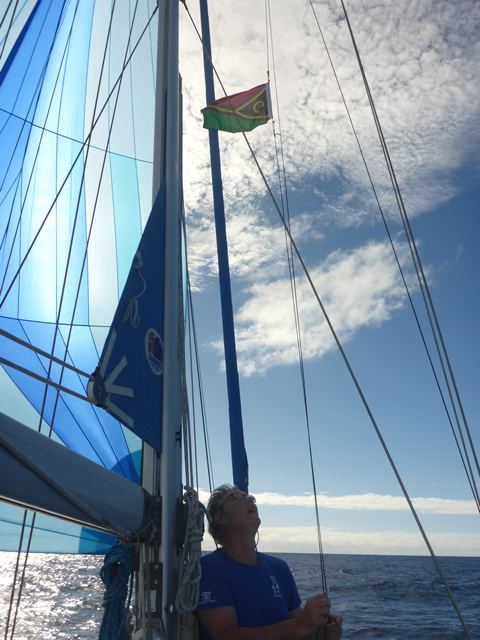
We had the rest of Jeannie’s home grown rhubarb cooked with crystallised ginger (to help ward off any nausea as well as tasting good) and Weetbix and yoghurt in oat milk for breakfast and we had just 318 miles to go to the tropics (23’ south latitude).
By now Zoonie was above 30’ south and beyond the full effects of any Lows tracking from the Tasman Sea across the top of NZ, so NZ really was well and truly behind us.
I so much prefer the gentle ride and efficiency of the Diva compared to goose-winging the genoa and main out either side, both held rigid with the boom and genoa stick and preventers and passing all the discomfort onto the boat. The Diva just flies high like a kite and moves from either side to counteract the roll of the hull. It takes 20 – 28 knots of wind to get 6 – 7 knots of speed from goose wings but just 7 – 12 knots to achieve the same speed from the Diva.
Should we leave her up there as we enter a moonlit night? We knew if there was a problem we would be out there like rats up a drainpipe, or under a pontoon (!) so we took the risk.
I was making notes by moonlight as she swayed from side to side until in the early hours she collapsed and then filled and banged taught straining her seams. Was that a one off or a warning? The sky was clear but a blast of wind can come from blue/black as well as grey/black. She collapsed again and Rob and I shot up and snuffed her into her bag and dropped her back into her dressing room, the forecastle for a well-earned rest. All on her own she had given us 100 miles in 15 hours, 6.666666666666 knots of speed recurring.
Later the moon was still hanging on at Zoonie’s left port side while the dawn crept into the eastern side on her starboard, right. We head north under full genoa which copes with whatever wind we get and at the time there was plenty.
Overnight we passed through a bank of fog and now have a head wind of light airs, doldrums, so Rupert the engine is on duty with the full mainsail holding her steady and giving one knot of extra drive, real motor sailing.
This morning I checked the school uniform boxes to make sure there was nothing in there but clothes. Suspicious maybe but we don’t want to spend the season in a Vanuatu jail and we neither packed them nor do we know who had access to them before we loaded them on board. All is good.
That evening I climbed into the saloon berth and went to sleep with the moon and space station shining down through Zoonie’s window.
So would you like to know where we were? At the time we were approaching The South New Hebrides Trench between the Norfolk Ridge and South Fiji Basin, all on the seabed you understand.
To celebrate our sixth day we had our first alcoholic drink, a delicious G & T while we chatted about this and that. Is the Indian Ocean really going to be different to everything we already know about the seaways we have experienced so far?
By early evening we were 39 miles from the Tropic of Capricorn, 23.30’ degrees south, so very nearly back in the tropics. I asked Neptune when he was going to send us the SE Trades, he told me to be patient.
The moon’s arrival was announced by an orange dome on the eastern horizon and by virtue of a careful bit of celestial planning it rose as the sun set so we had 24 hours of visibility to the horizon.
Rob mentioned an area of dark cloud to the west as he handed over to me at 4.00am. It looked like a boomerang and was approaching quickly bringing with it a nice breeze on our beam. So we set the sails and had an hour or so of nice quiet progress as Rupert cooled down. But that boomerang didn’t come back and sadly dragged the breeze with it.
Right now 11.15 pm your time on the 18th we are in the doldrums and rolling along at just over 6 knots under a blue sky with Rupert and the Auto Pilot George, (our second youngest grandson) in charge.
A Mysterious Night-time visitor, The Moon in its Moods and some Arses.
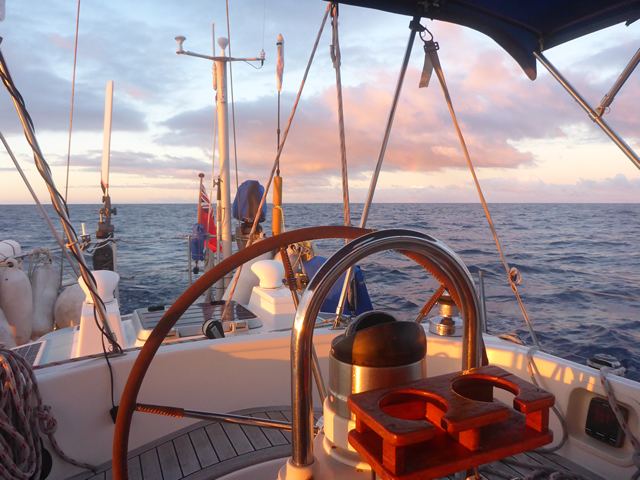
A successful day had been spent cooking up most of the remaining fresh veg and finishing the last blog. We were both researching our destination with the help of the Lonely Planet Guide 1995 written by David Harcombe and Denis O’Byrne and s/v Miz Mae’s Guide to Vanuatu 1998 by Nicola Rind, both second editions and looked forward to seeing how things have changed since way back then.
In the early night the moon rose in an orange glow in the east and lit up the night sky. A little spider had ambitiously started spinning a circular web between the aerial post and Hydrovane and it shone like a CD in the moonlight with the spider in the middle, waiting. When not giving generously of its reflected light the moon slid elusively behind silky clouds or stood solitary and proud draped in its diamond studded black sky.
Just before 5.00am, while in the process of turning off the engine, furling the main and letting the genoa work single handed we noticed the familiar signs of a nocturnal visitor, but the culprit was long gone leaving lots of white guano like thick deck paint. The wind was great for sailing, 10 to 17 knots just off her stern, a little too much for the Diva but the genoa was giving us a constant 6 knots plus so that was good and we could relax below.
We spent the morning passing Aneityum (prev: Anatom), the first inhabited island in the 84 island archipelago all dark and moody in the distance. A few metres away frigate birds hovered menacingly over a flock of Sooty Terns fishing below, ready to steal their catch. No, our visitor would not have been one of them, like shearwater they show no interest in us and terns have to be careful not to encounter the sea as their plumage becomes waterlogged. They have to sleep on the wing and rather like the young Royal Southern albatross we learned about in Otago who soar over the southern ocean for 5-6 years, young terns can spend the first three years of their lives at sea until they are old enough to breed.
Sooties are also known as Wide-awake terns because of the incessant deafening cacophony of noise they make on their breeding colonies at night, no doubt catching up on all the gossip.
Talking of albatross and along with them earlier in the voyage we saw Black-browed mollymawks. While looking up terns I found an under wing picture of one of these birds very similar to the photo I took. They are big birds at 90cm body length but not as grand as the Royal Albatross which can reach 145cm.
That night our visitor returned and sat on the end of the boom for a rest. As you can see from Rob’s great photo boobies can grip rope with their webbed feet, they just hadn’t done so on Zoonie before. It is a male brown booby bird as only they have blue faces.
Two more visited and one took up position on the top of the mast. We feared for the VHF aerial and the windex which gives us a visual on the wind direction.
Fortunately the aerial survived but somehow it managed to break the windex, the pointy end I later found on the side-deck. We saw a large flock of these birds busily feeding.
All down Zoonie’s starboard side the next day were conical volcanic islands and flatter ‘lava flow’ islands. Slowly Zoonie was climbing further up the chain in the direction of Espirito Santo and in particular its main town, Luganville. But first we had to navigate through the Selwyn Strait in the middle of the night. Named after Anglican bishop Selwyn who reported that despite the brutal activities of French ‘Blackbirders’ in the north of Maewo Island (more about this island and blackbirding later) he found the people of that island were the most pleasant and honest he had met in the entire archipelago.
From the eye of a booby on the wing a group of the northern Vanuatuan Islands together circle around to form a large bay. Starting on the southwest is Malacula Island (so named after some clan members got French sailors to sit down on some nice furry leaves and then proceeded to get them drunk on kava because they wanted to get rid of them. When they sobered up the sailors discovered the leaves contained a strong skin irritant, so they ran around yelling “Mal a cul” ‘pain in the arse’.)
To the east is Ambrym Island which has the Sewyn Strait lying between it and the thin north to south Pentecost Island. North again and joined with a subterranean link to Pentecost is Maewo Island of a similar shape and west of Ambrae with its live and very active volcano. Its caldera glows orange and our booby avoids flying over it. It made UK news not so long ago when all the inhabitants had to be evacuated twice because of dangerous eruptions. West again is Espirito Santo and to the south Malo Island north of Pain in the Arse Island.
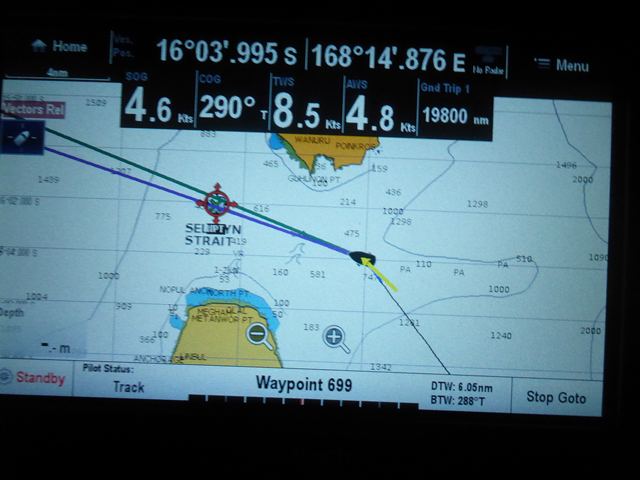
As the booby looks around he clearly sees the islands in the moonlight, the water shimmers between them and white lights, some along the shores and others further up the slopes gradually go out as the night progresses, the kava sessions finished and sleep time ensues. But wait, there is something in the water between the two islands. A tiny vessel making a dead straight wash with just one little sail flying at the front. Two people are moving around in the middle of the craft, “I think I’ll go and take a look, maybe I can rest a while.”
On board the couple are cautious about entering the strait, wondering if wind over tide is having an effect in the narrow passage, there isn’t quite enough light to see that far ahead. Will the water be rough or smooth, what is the rate of the tidal stream? They already know it is not directly in their favour from the direction of the blue tide line on the plotter screen. But all is very well as wind and water let the little vessel through without any discomfort.
Dawn spreads its watery light and the booby admires the pale blue sail flying off the front of the boat as it rocks very gently from side to side sending both the people on board into restful sleeps, at different times of course. The booby flies off to join its buddies for some fishing. Zoonie is on rails again, the islands protecting the ‘bay’ from the effect of the trade winds on the water. The blue sail has gone and a white sail is poled out with a little of the white sail behind the mast too, for balance. A perfect run across the ‘bay’.
While chatting over a cup of tea I was struggling to reach for the levers to open one of the front windows and let in some fresh air when Rob, while watching said, “You really are a little short arse, aren’t you.” After some thought I came out with, “If I was three inches taller I’d have beautiful legs,” poking the extra layer at the top of one, “This isn’t fat it’s POTENTIAL!”
I started doing some washing thinking our nice progress would help it to dry and cooked the rest of the fresh red cabbage so it wouldn’t be confiscated. The end of the voyage was in sight now. A long flat tree covered shoreline stopped with a lighter shore in the further distance and that was where we turned left into the Segond Channel. Just another six miles or so to go to our anchorage beyond the town and the Sarakata River, past the Luganville School into a little bay where we dropped the hook into sand and mud at 9 metres depth. We have covered 1247 miles in 10 days one and a half hours and used 91 ltrs of fuel, completing 229 days at sea from the start of our circumnavigation so far.
There are only three of us in the anchorage off Luganville and we must stay on board until we have been visited by Customs and Immigration sometime tomorrow. I sent the Inward Papers from NZ and they replied so they know we are coming, and now we’re here!
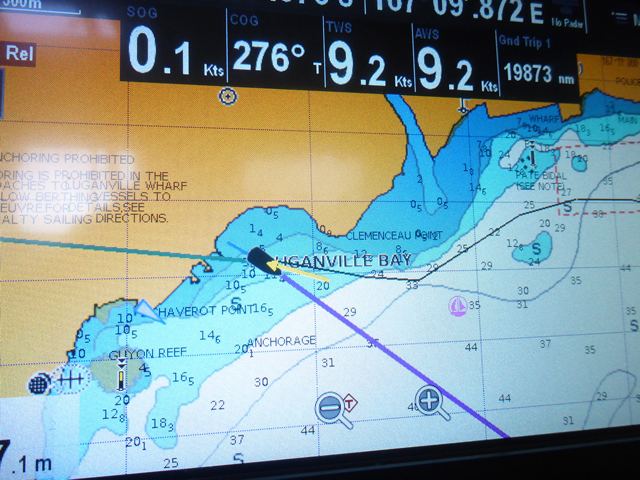
Tomorrow evening, Monday, is the start of the week’s markets, Tuesday, Thursday and Saturday and the evenings before, so we will be there with bells on. I can’t wait to get my hands on some nice Papaya again.
